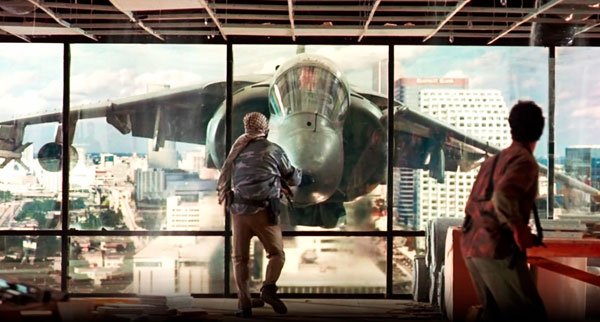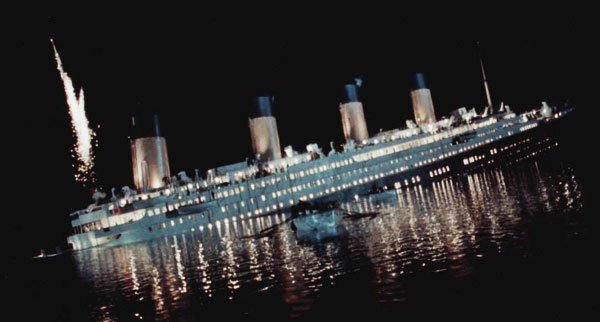Cash Cameron: James's Budget-Busters From The Abyss To Avatar

James Cameron has been touting Avatar as the movie that will redefine filmmaking, the future of movie-dom to come. That has yet to be seen, but there's one place Cameron’s movie is likely going: a budget where no movie has gone before.
As it turns out, his movies have been there before...more than once. In fact, pretty much every movie he makes redefines "most expensive movie ever made." If you had to pick a theme song for Cameron's career, you might choose a death metal number to reflect his abusive nature or something inspirational in honor of his visionary storytelling. Me, I would go with "Hey Big Spender". Cameron's not known for fun and laughs, but he regularly breaks the record for the most money blown on a film budget.
And best of all, Cameron doesn't care. He knows what he's doing, he knows what he wants, and he could care less how much it costs to get it done. Every time he releases a movie, he's asked about his massive budgets, and he usually throws it back with profanity-laced laissez-faire. After all, when you're an artist, who cares about the money, right?
Let the producer beware! Here's a look at "Cash" Cameron's twenty year record-shattering spending spree.

The Abyss (1989)
Cost: $70 million
These days $70 million isn't anything to get excited about, but in the late Eighties it was considered an obscene about of money. Batman ran for a mere $35 million, Indiana Jones and the Last Crusade only cost $45 million.
Your Daily Blend of Entertainment News
But when Cameron gets behind the camera he never settles for second best, and he pulled out all the stops for The Abyss, a movie set at the bottom of the ocean. His production converted an unfinished nuclear plant into a giant aquarium to make the world's largest submerged set. He invented an entirely new kind of scuba helmet so that he could see his actors' faces during their underwater shots. And he pioneered a new kind of special effect to craft one of his submariner aliens.
Of course, a production shot almost entirely underwater is bound to run into all kinds of schedule and technical problems, which led to even higher costs. At the end of the day he blew $70 million to make his sci-fi masterpiece, and as a fan of the movie I'd say it was well worth it.
Audiences weren't quite so excited. The movie only banked $54 million at the US box office, and international sales only helped it to reach $90 million. Since the studio doesn't see 100% of the sales, it's likely Fox ended up underwater on The Abyss too, but that didn't stop other studios from risking even more on Cameron's spending habit.

Terminator 2: Judgment Day (1991)
Cost: $102 million
In the year that followed The Abyss, movie budgets got a little bolder. Total Recall ran a tab at $65 million and Die Hard 2 punched in at $70 million. Not to be undone, Cameron decided to crack the triple-digit barrier.
[[ br. ]] Terminator movie was filmed on a guerilla level $7 million, he spared no expense on its top-of-the-line sequel. The collateral damage increased exponentially, the sets and special effects got a major boost, the actors saw a hefty salary increase, and the price tag grew faster than Eddie Furlong's Tiger Beat popularity.
At $102 million, it was the most expensive movie ever made. Unlike The Abyss, however, audiences turned out in droves. At $204 million in domestic sales it became the third-highest-grossing Rated R movie at the time, and the number one movie of 1991.
Despite the movie's success, it would be a while before studios got comfortable with the numbers in the $100+ millions, and Cameron remained Hollywood's biggest spender.
[[ br. ]]

True Lies (1994)
Cost: $115 million
[[ br. ]]
Even if no one else in Hollywood jumped on the $100+ million budget bandwagon, Cameron felt no need to constrain himself. When his next movie True Lies rolled out he topped himself again.
I'm not entirely sure that the movie really needed that much money, but with Cameron there's no going for less. And thank goodness for that: bridge-way explosions with helicopter rescues, a big salary for Arnold (Schwarzenegger, not Tom) and an awesomely gratuitous action scene with a skyscraper and a Harier jet. Money well spent.
At over $115 million it was once again the biggest wad of cash blown on a single flick. So now Cameron could not only claim he was the top spender, he could also claim to be the only person brave enough to outspend himself. The cash spree paid off. True Lies banked almost $400 million world-wide.
[[ br. ]]

Titanic (1997)
Cost: $200 million
[[ br. ]]
In 1995 Kevin Costner stunned the planet with Waterworld. Not that the movie itself was stunning, just the amount it cost. It upped the budget ante by a huge margin, clocking in at a whopping and unbelievable $175 million. While it didn't turn a huge profit, it did dwarf the money being spent on any other movie at the time. Cameron would not let himself be outdone.
With Leo, Kate and Celine Dion in tow, Cameron set out to re-sink the Titanic in what would be one of the longest (3 hours, 14 minutes), and longest running (almost four months at number one and over ten months in theaters) movies on the books. And it wouldn't have been a Cameron movie if it wasn't also the most expensive. Gambling that the epic historical-romantic-tragedy would be all the rage, he dropped a once-again record-breaking $200 million to get the film to theaters in 1997.
Paramount was shaking in their loafers when it opened at only $28 million, but they underestimated Cameron's ability to generate excitement among the teenybopper crowd. Over the following weeks his money-pit turned into the biggest money-maker in history, thanks in no small part to heart-throb Leonardo DiCaprio (OK, the boat sinking was kind of cool too). Even though other movies have since topped Cameron's budget record (Pirates of the Caribbean: At World's End holds that title at $300 million), its $600 million in domestic sales and $1.8 billion in overall world sales have topped the chart for the last 12 years.
[[ br. ]]

Ghosts of the Abyss (2003)
Cost: $14 million
[[ br. ]]
Even when he's making documentaries, Cameron could care less about the cost. His return trip to the Titanic in Ghosts of the Abyss was his opportunity to revisit one of his favorite landmarks and a chance to develop his 3D filming technology.
$14 million may sound like a minimal cost for a film, but in the world of documentaries it's downright luxurious. Indie-type efforts usually go for less than one week's worth of craft-service on a blockbuster set. Morgan Spurloch's Super-Size Me was only $65,000. Antarctic adventure March of the Penguins came in at just $8 million. Even Michael Moore's carefully crafted pseudocumentaries don't break into the $10 million mark.
[[ br. ]]

Avatar (2009)
Cost: ????
[[ br. ]]
Nobody seems to have a firm grip on how much Cameron’s latest special-effects orgy is going tally up. The most recent info from the Hollywood Reporter says industry insiders estimate the total will be over $300 million. Excitable wackos are claiming it’s something closer to half-a-billion bucks. The studio hasn’t released anything official, but its original estimates placed the sum at $240 million.
And what does Cameron have to say? As always, he could care less, and he doesn’t care about the speculation hub-bub either. "I don't think it means jack shit,” he told THR. "To be perfectly honest, I think the studio has generated the myth about its costs to help in the selling of the movie."
But he’s happy to do a little spinning of his own. He continued, "By the way, doesn't that mean it's a bargain to see such an expensive film for the same amount it costs to see any other film? It's the deal of the century!"
